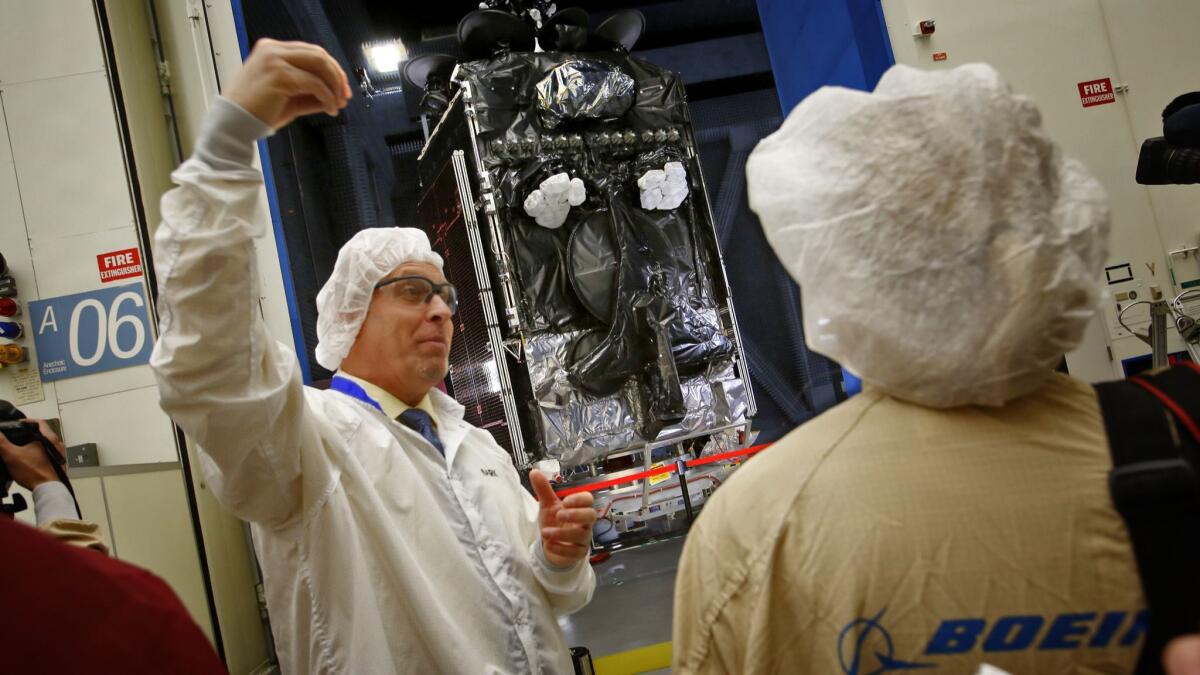Southern California suppliers learn to adjust to slowdown in satellite orders

SpaceX on Tuesday blasted six small commercial satellites to low-Earth orbit. It was the company’s 10th launch this year — but the payload itself may be a sign of what’s to come.
Like many companies, Iridium Communications Inc. has been developing a constellation of satellites. Those smaller satellites are set to gradually replace the giants that traditionally handled broadcast and other communications from 22,000 miles above the Earth.
In a reflection of that shift, SpaceX itself expects to launch fewer satellites next year — around 20, down from as many as 28 this year — because orders for commercial geostationary satellite launches have fallen off.
“The market has decreased a little bit,” SpaceX President Gwynne Shotwell said in an interview on CNBC. Worldwide orders for the school bus-sized spacecraft that operate in a fixed place relative to the ground typically numbered 20 to 25 a year until 2015, when they dropped to 17.
The change rippled out to companies such as Alliance Spacesystems of Los Alamitos, which makes composite and lightweight structures for satellite components such as solar arrays and antenna reflectors. Its sales fell 60% from $30 million in 2015 to $12 million in 2016. The company laid off “a good portion” of its workforce, including 54 of its 85 technicians, said Rick Byrens, Alliance’s senior vice president and general manager.
“We never saw a downturn like we saw in 2016,” he said.
Satellite suppliers have been hit with a double whammy. Thanks to technological advancements, new geostationary satellites are more capable than ever, so fewer are needed. At the same time, new types of satellites are being built that reflect changed video viewing habits.
SpaceX is among the companies developing networks of hundreds or even thousands of tiny, cheaper satellites to beam low-cost Internet access to customers.
“So many of the services that are being done by the big, geostationary satellites may well be done by some of these new, big constellations,” said Marco Caceres, senior space analyst at market analysis firm Teal Group.
While satellite industry experts say that order numbers can be cyclical, the most recent shift sent suppliers scrambling across California.
In 2015, L3 Electron Devices’ Torrance facility was almost entirely focused on space products. It says it is the only U.S. manufacturer of a type of vacuum-tube technology that amplifies radio signals through space. When the slowdown hit, management decided to combine the Torrance facility with work done at another plant in Northern California that was producing the same type of technology for aircraft, such as General Atomics’ Predator drone, according to an L3 official.
Today, space systems account for only about 40% of L3 Electron Devices’ business.
Two weeks ago, Westminster, Colo., firm Maxar Technologies Ltd. told analysts during a quarterly earnings call that company revenue declined 5% on a pro-forma basis from the same period last year, partially from lower contract award amounts and “continued weakness” in the geostationary commercial satellite market.
Maxar owns Palo Alto-based satellite and spacecraft manufacturer SSL, as well as Earth-imagery provider DigitalGlobe.
Chief Executive Howard Lance told analysts he hoped Maxar would start to see “the bottoming” of the impact of the geostationary business, though he noted that the company believes there will be a “sustained lower level” of satellite orders.
The lower order forecast shook up Santa Barbara supplier Deployable Space Systems, which had been counting on SSL’s business for its advanced solar arrays.
The company was worried for about a year, said Brian Spence, president of Deployable Space Systems. But it was able to capture solar array orders for interplanetary and low-Earth orbit spacecraft.
Commercial geostationary satellite operators also have started to hedge their bets by entering the market for smaller, largely broadband satellites.
Canadian operator Telesat announced plans to launch a low-Earth orbit constellation. Japanese operator SKY Perfect JSAT Corp. has invested in Washington, D.C.-based LeoSat Enterprises, which plans to launch up to 108 satellites to provide broadband access for businesses.
Even Alliance sees opportunity in these new constellations. Its parent company, Albuquerque-based SolAero Technologies Corp., will produce solar panels for OneWeb’s small-satellite constellation, and Alliance will make the support structures for the satellites’ solar arrays.
“It’s obviously a huge program for our corporation,” Byrens said. “You go from a GEO [geostationary satellite], which is one satellite, to now 700 satellites.”
Indeed, Alliance has bounced back this year as its main customer, Boeing Co., recently won several commercial geostationary satellite orders after it made inroads in the high-capacity satellite market. Alliance was able to call back many laid-off workers, and its technician force is now back to 102. Alliance has forecast sales of $38 million this year.
But not all suppliers will be able to cash in on the proposed constellations.
“If you’re talking about making 1,000 satellites at an affordable price point, it’s just going to be a different supply base,” said Jim Adams, principal in the aerospace and defense practice at KPMG. “It’s just different technologies.”
Satellite industry experts say large, commercial geostationary satellites likely will never completely disappear, and more complex satellites could mean fewer numbers of orders generating more dollars. That makes landing each remaining order all the more critical.
Government satellites, which traditionally have been large, geostationary spacecraft, are another lucrative source of revenue.
However, the government communications satellites are transitioning to a new generation as well, said Bill Ostrove, aerospace and defense analyst at Forecast International. And a new program from the Pentagon’s Defense Advanced Research Projects Agency, or DARPA, is urging contractors to focus on small-satellite launchers — indicating that the Defense Department also is looking into the possibility of using small satellites.
Twitter: @smasunaga
More to Read
Inside the business of entertainment
The Wide Shot brings you news, analysis and insights on everything from streaming wars to production — and what it all means for the future.
You may occasionally receive promotional content from the Los Angeles Times.











